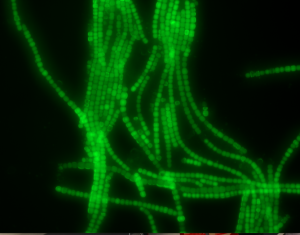Using 3D printing, researchers at Stevens Institute of Technology have created a bionic mushroom. Why? For good reason, actually. The researchers are working to better understand the biological machinery of cells and how they can be used to create new technologies for defense, healthcare and the environment.
The mushroom – an ordinary white one from a grocery store – was modified with 3D printed clusters of cyanobacteria that generate electricity as well as graphene nanoribbons that collect the current.
“In this case, our system – this bionic mushroom – produces electricity,” said Manu Mannoor, an assistant professor of mechanical engineering at Stevens. “By integrating cyanobacteria that can produce electricity, with nanoscale materials capable of collecting the current, we were able to better access the unique properties of both, augment them, and create an entirely new functional bionic system.”
 In the world of bioengineering, cyanobacteria’s ability to produce electricity has been known for a long time; however, the cyanobacteria do not survive for long on artificial biocompatible surfaces, meaning that scientists have been limited in their ability to use the organisms in bioengineered systems. Mannoor and postdoctoral fellow Sudeep Joshi came up with the idea of using mushrooms because they naturally host a complex microbiota and could potentially provide the nutrients, moisture, pH and temperature necessary for the cyanobacteria to survive and produce electricity.
In the world of bioengineering, cyanobacteria’s ability to produce electricity has been known for a long time; however, the cyanobacteria do not survive for long on artificial biocompatible surfaces, meaning that scientists have been limited in their ability to use the organisms in bioengineered systems. Mannoor and postdoctoral fellow Sudeep Joshi came up with the idea of using mushrooms because they naturally host a complex microbiota and could potentially provide the nutrients, moisture, pH and temperature necessary for the cyanobacteria to survive and produce electricity.
In their lab, Mannoor and Joshi were able to get the cyanobacteria to last several days longer when placed on the cap of a white button mushroom than they did when placed on a dead or artificial mushroom.
“The mushrooms essentially serve as a suitable environmental substrate with advanced functionality of nourishing the energy producing cyanobacteria,” said Joshi. “We showed for the first time that a hybrid system can incorporate an artificial collaboration, or engineered symbiosis, between two different microbiological kingdoms.”
The two researchers first used a robotic arm-based 3D printer to print an electronic ink containing the graphene nanoribbons, which served as an electricity-gathering network. They then printed a bio-ink containing the cyanobacteria onto the mushroom’s cap in a spiral pattern intersecting with the electronic ink at multiple points. At these locations, electrons could transfer through the outer membranes of the cyanobacteria to the conductive network of graphene nanoribbons. When a light was shone on the mushrooms, cyanobacterial photosynthesis was activated and a photocurrent was generated.
 The researchers showed that the amount of electricity the bacteria produce can vary depending on the density and alignment with which they are packed – the more densely packed together they are, the more electricity they produce. 3D printing allowed them to assemble the bacteria so as to boost their electricity-producing activity eight times more than cyanobacteria that was casted using a pipette.
The researchers showed that the amount of electricity the bacteria produce can vary depending on the density and alignment with which they are packed – the more densely packed together they are, the more electricity they produce. 3D printing allowed them to assemble the bacteria so as to boost their electricity-producing activity eight times more than cyanobacteria that was casted using a pipette.
Manoor, Joshi and co-author Ellis Cook are the first to pattern 3D printed bacterial cells to augment their electricity-generating behavior, and also to integrate it to develop a functional bionic architecture.
“With this work, we can imagine enormous opportunities for next-generation bio-hybrid applications,” Mannoor said. “For example, some bacteria can glow, while others sense toxins or produce fuel. By seamlessly integrating these microbes with nanomaterials, we could potentially realize many other amazing designer bio-hybrids for the environment, defense, healthcare and many other fields.”
Discuss this and other 3D printing topics at 3DPrintBoard.com or share your thoughts below.
[Source/Images: Stevens Institute of Technology]
Subscribe to Our Email Newsletter
Stay up-to-date on all the latest news from the 3D printing industry and receive information and offers from third party vendors.
You May Also Like
3D Printing Financials: Fathom Struggles in Financial Quicksand During Critical Transition
Facing a year of key transitions and financial pressures, Fathom (Nasdaq: FTHM) has filed its annual report for 2023 with the U.S. Securities and Exchange Commission (SEC). The document outlines...
Latest Earnings Overview for Australian 3D Printing Firms Titomic and AML3D
Australian 3D printing manufacturing firms Titomic (ASX: TTT) and AML3D (ASX: AL3) reported their financial results for the period from July to December 2023, marking the first half of their...
3D Printing Webinar and Event Roundup: April 7, 2024
Webinars and events in the 3D printing industry are picking back up this week! Sea-Air-Space is coming to Maryland, and SAE International is sponsoring a 3D Systems webinar about 3D...
3D Printing Financials: Unpacking Farsoon and BLT’s 2023 Performance
In the Chinese 3D printing industry, two companies, Farsoon (SHA: 688433) and Bright Laser Technologies, or BLT (SHA: 688333), have recently unveiled their full-year earnings for 2023. Farsoon reported increases...
































